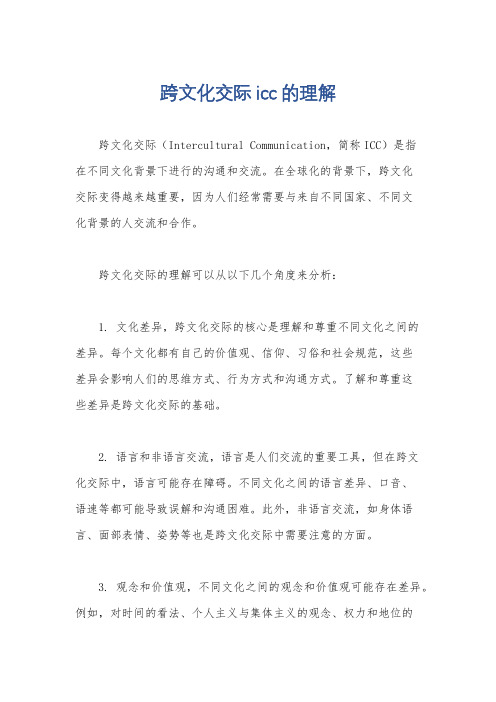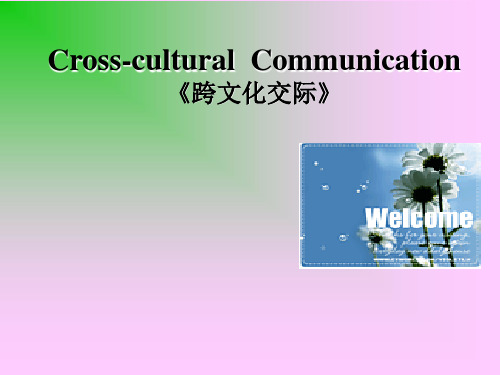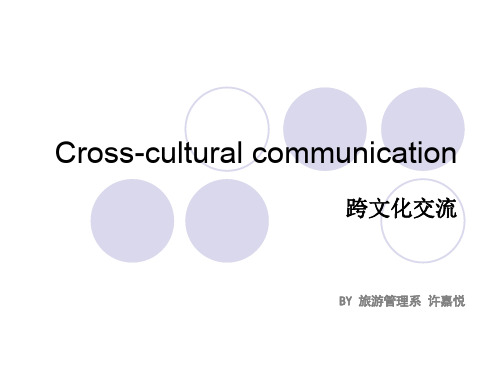跨文化交流Communication
跨文化交际unit6-verbal-communication

❖ 引言:
❖
各民族的语言是自足的. 处于不同语言世界里的人,即使面对同一个现实面向,
也会在描述它时沿着各自的思路,采用不同的策略, 刻画出不同的版本.正如维特
根斯坦所言:我的语言就是我的疆界,跨出我生于其中的语言,冒险与隔膜就开始
了.
❖
语言与文化紧密相连, 不可分割; 语言是文化的一部分.
❖ Culture and language are intertwined and are shaping each other. Each time we select words, form sentences, and send a massage, either oral or written, we also make cultural choices.
❖ ( Beamer, L. and Varner, I Intercultural communication in the Global Workplace. New York, NY:
❖ Teaching objectives: ❖ In this part you are expected to understand some commonly observed differences
The power of verbal communication
Ⅰ. cultural differences on lexical level ❖ (cases) ❖ 1. types of lexical meaning ❖ Words are the basic units of meaning. Understanding
❖ farther and farther away from home.
跨文化沟通(cross-culture_communication)

多元化
• 多元化的影响:在种族、性别、民族语言 以及性取向等问题在国家政治中日益受到 关注的同时,他们同样影响着人们的工作 环境。
• 原则:当别人跟你谈及一个话题时,要根 据你们两者间现有的相互了解的程度进行 讨论。(例如:打招呼)
cross-cultural communication
跨文化沟通:
定义:
跨文化沟通是指跨文化组织中拥有不同文化背景 的人们之间相互传递信息、交流知识和理解情感的过 程。
每个国家甚至每个族群都 有这自己特有的文化,有些 语言、动作、眼神、表情等 传达信息的方式在你自己所 在的区域内是代表着一种意 思但是在另外一个地方可能 就不是同一种意思。
• 解决多元化的困惑方式:
1、听从律师的建议。不要问一些连自 己都不知道答案的问题。 2、坦率地表露自己的文化困惑,向遇 到过类似困惑的同事寻求帮助。
1、文化困惑: 文化困惑存在在许多方面比如关于私人问题的困惑,商务交往中的困惑 ,民族文化的困惑及语言交流的困惑等等。 2、如何处理文化困惑: (1)、树立跨文化意识。可以主动学习对方的语言、历史、文化和风俗 习惯。 (2)、正确对待文化差异。首先要承认文化差异,其次要正确对到文化 差异。
当塞车时:
日本人:拉长了脸,呆在车里一心中的不耐烦。
美国人:往往拿出一支用 以减轻堵车烦恼的玩具冲 锋枪,扣动扳机,“哒哒” 地扫射一阵,据说此举能 帮助重获“心理平衡”。
德国人:此时应属于最奇特的一种,不但不心烦, 反而感到快乐,这在世界各民族中也许是绝无仅 有的。
• 在经济全球化的过程中,为了培养一名合适的管理人员,必须让他同 来自不同文化背景的学生一起学习
跨文化交流简介(Intercultural Communication)

•
•
1. Intercultural communication as a human activity
•
The history of communication between people of different cultural backgrounds is almost as long as human history itself. Can you list any kinds of communication between people with different cultural backgrounds?
What is intercultural communication?
•
In the most general sense, intercultural communication occurs when a member of one culture produces a message for consumption by a member of another culture. More precisely, intercultural communication is communication between people whose perceptions and symbol systems are distinct enough to alter the communication event.(From Communication Between Cultures by Larry A. Samovar, Richard E. Porter & Lisa A. Stefani)
3. Founders of the Field of ICC
跨文化沟通(cross-culture-communication)

当塞车时:
日本人:拉长了脸,呆在车里一声不吭。
德国人:此时应属于最奇特的一种,不但不心烦, 反而感到快乐,这在世界各民族中也许是绝无仅 有的。一位德国工程师对此解释说,此时会产生 一种“共度难关”时的“同志式感觉”——大家 可以好好地一起感叹上一阵子,等道路畅通,一 种共同被“解放”的轻松感又会油然而生。 中国人:最有行动力的应当属于中国人,在焦急 等待中走出车厢,自己充当交警。
日本人是用眼吃饭: 说日本人用眼吃饭,并不是贬低日本人,而是日本人长期的岛国 心态,造就了他们的饮食习惯,由于日本是一岛国,物产相对来说比 较匮乏,有的食材需要长期进口,所以他们把饮食的风格放在少而精 上,做得量很少,但是食材选择以活的海鲜为主,用的器皿也是非常 讲究,但是都突出一个小字,让人吃起来赏心悦目,但是每次的食量 都不是太大,所以我们中国人吃日本料理都说吃不饱,而日本人却养 成这样的饮食习惯,所以你在日本很少见到大腹便便的人。
意大利人:不停地按喇叭, 以发泄心中的不耐烦。
奥地利人:往往猛烈击掌,表示焦急。
荷兰人: 一般会用 力跺脚, 表示“已 缺乏耐 心”。
视会 卢 后大 森 又扮 堡 大鬼 人 笑脸 : 。, 此 互时
美国人:往往拿出一支用 以减轻堵车烦恼的玩具冲 锋枪,扣动扳机,“哒哒” 地扫射一阵,据说此举能 帮助重获“心理平衡”。
cross-cultural communication
小组成员: 陈莎 赖瑶 阳靓芳 魏巧明 郑天 向卫平 唐文德
跨文化传播学关键术语解读

跨文化传播学关键术语解读跨文化传播学是研究不同文化之间的相互影响、交流和传播过程的学科。
在这个学科领域中,有一些关键术语是至关重要的,对于理解和解释跨文化传播现象具有重要意义。
下面将对其中几个关键术语进行解读,并提供相关参考内容。
1. 跨文化交流(intercultural communication):指不同文化之间的信息传递、理解和共享过程。
跨文化交流是解决文化差异问题和促进跨文化合作的重要手段。
参考内容:文化差异是跨文化交际的核心问题之一。
克里斯滕森(Christopher)指出,文化差异在跨文化交流中表现为语言和非语言差异、态度和价值观差异以及行为和礼仪差异。
在跨文化交际过程中,必须意识到并尊重对方的文化差异,同时培养跨文化沟通能力,以促进有效的交流和理解。
2. 文化霸权(cultural imperialism):指一个文化群体对其他弱势文化群体进行操控和影响的过程。
文化霸权常常伴随着经济、政治和军事力量的不平衡,在全球化的过程中比较常见。
参考内容:文化霸权是一个复杂的现象,常常存在于西方国家文化对其他国家的影响中。
尼尔(Neil)指出,文化霸权是一种意识形态的扩张,通过媒体、教育和商业等手段对其他文化进行塑造和影响。
反对文化霸权的观点认为,文化多样性是保护和发展每个国家独特文化的重要条件。
3. 文化认同(cultural identity):指一个人或群体对自己所属文化的认同感和归属感。
文化认同是个体和群体对自我身份的理解和建构的重要基础。
参考内容:文化认同是一个复杂的概念,常常与个体和社会的需求密切相关。
草本(Clayborne)指出,文化认同通过语言、价值观、习惯等方面的共同体验来建立,并在个体和群体的生活和行为中得以体现。
在跨文化传播中,理解和尊重他人的文化认同是建立和谐关系的重要前提。
4. 跨文化可信度(intercultural credibility):指在跨文化交流中,个体或群体在他人眼中符合期望、可靠可信的程度。
跨文化交际icc的理解

跨文化交际icc的理解跨文化交际(Intercultural Communication,简称ICC)是指在不同文化背景下进行的沟通和交流。
在全球化的背景下,跨文化交际变得越来越重要,因为人们经常需要与来自不同国家、不同文化背景的人交流和合作。
跨文化交际的理解可以从以下几个角度来分析:1. 文化差异,跨文化交际的核心是理解和尊重不同文化之间的差异。
每个文化都有自己的价值观、信仰、习俗和社会规范,这些差异会影响人们的思维方式、行为方式和沟通方式。
了解和尊重这些差异是跨文化交际的基础。
2. 语言和非语言交流,语言是人们交流的重要工具,但在跨文化交际中,语言可能存在障碍。
不同文化之间的语言差异、口音、语速等都可能导致误解和沟通困难。
此外,非语言交流,如身体语言、面部表情、姿势等也是跨文化交际中需要注意的方面。
3. 观念和价值观,不同文化之间的观念和价值观可能存在差异。
例如,对时间的看法、个人主义与集体主义的观念、权力和地位的认知等。
了解和尊重对方的观念和价值观,可以帮助建立良好的跨文化交际。
4. 文化敏感性,跨文化交际需要具备文化敏感性,即能够意识到自己的文化背景对交流的影响,并且尊重和适应对方的文化。
这包括对自己的文化偏见和刻板印象的认知,以及对不同文化之间的平等和互惠的态度。
5. 适应和灵活性,在跨文化交际中,适应和灵活性是非常重要的。
这意味着能够适应不同的沟通风格、礼仪习惯和社交规则,并且愿意调整自己的行为和语言,以更好地与对方进行交流。
6. 跨文化冲突解决,由于文化差异,跨文化交际中可能会出现冲突和误解。
解决跨文化冲突需要开放的心态、耐心和善意的沟通。
通过倾听、提问和解释,可以减少误解并找到共同的解决方案。
总而言之,跨文化交际是一种理解和尊重不同文化差异的沟通和交流方式。
它需要我们具备文化敏感性、适应能力和解决冲突的能力,以建立良好的跨文化关系。
通过有效的跨文化交际,我们可以促进文化交流、增进相互理解,并在全球化时代中实现更好的合作和发展。
Cross-cultural Communication 跨文化交际 PPT课件 (2)

5.Case studies
Mutual Monitoring Process
Xiu went to a BC buffet reception in the BC headquarters in Beijing. It just so happened that Xiu arrived a little too early. The waiting lounge was almost empty except a charming lady sitting at a corner seat. After a long interval of unbearable silence Xiu decided to break the silence by approaching the lady.
Yes, but not good
1.An orator delivers a speech to a large gathering. 3. You send an e-mail message to an American friend. 4.Jane lies in bed reading a novel.
Model Two: unilateral-cultural model
(one knows another’s language and cultural environment but the other one doesn’t)
Lu Bing ,a Chinese tour guide is talking in English with George Luke, a British tourist who does not know Chinese at all.
Activity 3: Meanings in communication
跨文化交流Cross-culturalcommunication

7.人口迁移
移民 人口老龄化 多文化社会
2005
2012年4月16日,7-11便利店将开放个人加 盟,年龄在22-52岁的中国籍人士,通过公 司审核后,投资30万即可成为便利店主。
试设想……
将来的某一天,你会有机会在一间全球连锁的企 业或者是她的子公司工作。
从发展现状来看,跨国公司已经成为重要的经济 体,在世界经济贸易中的地位日益突出。与政府 不一样的是,这些商业巨头并不透明,她们只对 自己的股东负责,甚少受到到规范约束。
全球化包括了涉及整个世界以及带来世界 范围内影响的一切行为和过程。
全球化(globalization)一词,是一种概念,也 是一种人类社会发展的现象过程。全球化目前有 诸多定义,通常意义上的全球化是指全球联系不 断增强,人类生活在全球规模的基础上发展及全 球意识的崛起。国与国之间在政治、经济贸易上 互相依存。全球化亦可以解释为世界的压缩和视 全球为一个整体。二十世纪九十年代后,随着全 球化势力对人类社会影响层面的扩张,已逐渐引 起各国政治、教育、社会及文化等学科领域的重 视,纷纷引起研究热潮。对于“全球化”的观感 是好是坏,目前仍是见仁见智。
请设想:
你在巴黎卢浮宫内游览,正在欣赏《蒙娜丽莎的 微笑》时,你妈妈给你打电话了。
你在北京坐公交车,正用手机在看一个有趣的视 频,但你身边的人正倾身跟你一起看这个视频。
你正在与一位沙特阿拉伯的客人一起开一个重要 的会议,这时候你公司的老总给你发信息来说, 你鼻血立刻给他回复他早前发给你的邮件。
达的信息 第七章 文化对语境的影响:商务情境 第八章 尝试进入新的文化:做一个优秀的跨文化
- 1、下载文档前请自行甄别文档内容的完整性,平台不提供额外的编辑、内容补充、找答案等附加服务。
- 2、"仅部分预览"的文档,不可在线预览部分如存在完整性等问题,可反馈申请退款(可完整预览的文档不适用该条件!)。
- 3、如文档侵犯您的权益,请联系客服反馈,我们会尽快为您处理(人工客服工作时间:9:00-18:30)。
CommunicationIt is a process of transferring information from one entity to another. Communication processes are sign-mediated interactions between at least two agents which share a repertoire of signs and semiotic rules.Communication is commonly defined as "the imparting or interchange of thoughts, opinions, or information by speech, writing, or signs".Communication is a process whereby information is enclosed in a package and is channeled and imparted by a sender to a receiver via some medium. The receiver then decodes the message and gives the sender a feedback. All forms of communication require a sender, a message, and an intended recipient; however the receiver need not be present or aware of the sender's intent to communicate at the time of communication in order for the act of communication to occur.Communication requires that all parties have an area of communicative commonality. There are auditory means, such as speech, song, and tone of voice, and there are nonverbal means, such as body language, sign language, paralanguage, touch, eye contact, through media, i.e., pictures, graphics and sound, and writing.Human communicationHuman spoken and written languages can be described as a system of symbols and the grammars can be described as rules by which the symbols are manipulated. The word "language" is also used to refer to common properties of languages. Language learning is normal in human childhood. Most human languages use patterns of sound or gesture for symbols which enable communication with others around them. There are thousands of human languages, and these seem to share certain properties, even though many shared properties have exceptions.Non-Verbal communicationNon-Verbal communication is the process of communicating through sending and receiving wordless messages. Such messages can be communicated through gesture, body language or posture; facial expression and eye contact, object communication such as clothing, hairstyles or even architecture, as well as through an aggregate of the above, such as behavioral communication. Nonverbal communication plays a key role in every person's day to day life, from employment to romantic engagements.Speech may also contain nonverbal elements known as paralanguage, including voice quality, emotion and speaking style, as well as prosodic features such as rhythm, intonation and stress.Likewise, written texts have Non-Verbal elements such as handwriting style, spatial arrangement of words, or the use of emoticons. A portmanteau of the English words emotion (or emote) and icon, an emoticon is a symbol or combination of symbols, such as :), used to convey emotional content in written or message form.Other communication channels such as telegraphy fit into this category, whereby signals travel from person to person by an alternative means. These signals can in themselves be representative of words, objects or merely be state projections. Trials have shown that humans can communicate directly in this way without body language, voice tonality or words.Categories and Features of Non-Verbal CommunicationG. W. Porter divides non-verbal communication into four broad categories:∙Physical. This is the personal type of communication. It includes facial expressions, tone of voice, sense of touch, sense of smell, and body motions.∙Aesthetic.This is the type of communication that takes place through creative expressions: playing instrumental music, dancing, painting and sculpturing.∙Signs. This is the mechanical type of communication, which includes the use of signal flags, the 21-gun salute, horns, and sirens.∙Symbolic. This is the type of communication that makes use of religious, status, or ego-building symbols.Static Features∙Distance.The distance one stands from another frequently conveys a Non-Verbal message. In some cultures it is a sign of attraction, while in others it may reflect status or the intensity of the exchange.∙Orientation.People may present themselves in various ways: face-to-face, side-to-side, or even back-to-back. For example, cooperating people are likely to sit side-by-side while competitors frequently face one another.∙Posture.Obviously one can be lying down, seated, or standing. These are not the elements of posture that convey messages. Are we slouched or erect? Are our legscrossed or our arms folded? Such postures convey a degree of formality and the degree of relaxation in the communication exchange.∙Physical Contact. Shaking hands, touching, holding, embracing, pushing, or patting on the back all convey messages. They reflect an element of intimacy or a feeling of (or lack of) attraction.Dynamic Features∙Facial Expressions.A smile, frown, raised eyebrow, yawn, and sneer all convey information. Facial expressions continually change during interaction and are monitored constantly by the recipient. There is evidence that the meaning of these expressions may be similar across cultures.∙Gestures. One of the most frequently observed, but least understood, cues is a hand movement. Most people use hand movements regularly when talking. While some gestures (e.g., a clenched fist) have universal meanings, most of the others are individually learned and idiosyncratic.∙Looking.A major feature of social communication is eye contact. It can convey emotion, signal when to talk or finish, or aversion. The frequency of contact may suggest either interest or boredom.Visual communicationVisual communication is communication through visual aid. It is the conveyance of ideas and information in forms that can be read or looked upon. Primarily associated with two dimensional(See also Three dimensional) images, it includes: signs, typography, drawing, graphic design, illustration, color and electronic resources. It solely relies on vision. It is form of communication with visual effect. It explores the idea that a visual message with text has a greater power to inform, educate or persuade a person. It is communication by presenting information through visual form.Understanding the Field of CommunicationThe field of communication is typically broken into three distinct camps: human communication, mass communications, and communication disorders.Human Communication or Communication Studies is the study of how individuals communicate. Some examples of the distinct areas that human communication scholars study are:∙Interpersonal Communication∙Organizational Communication∙Oral Communication∙Small Group Communication∙Intercultural Communication∙Nonviolent Communication∙Conflict∙Rhetoric∙Public Speaking∙Media and Communications PsychologyExamples of Mass Communications include:∙Mass communication∙Graphic communication∙Science communication∙Strategic Communication∙Superluminal communication∙Technical communication∙Public relations∙Broadcast Media∙Journalism∙Media and Communications PsychologyExamples of Communication Disorders include:∙Facilitated Communication∙Impairment of Language Modality∙Speech DisordersOral communicationOral communication is a process whereby information is transferred from a sender to receiver; in general communication is usually transferred by both verbal means and visual aid throughout the process. The receiver could be an individual person, a group of persons or even an audience.There are a few of oral communication types: discussion, speeches, presentations, etc. However, often when you communicate face to face the body language and your voice tonality has a bigger impact than the actual words that you are saying. "Communication is 55% body language, 38% tone of voice, 7% content of words", the so-called "7%-38%-55% rule”. For example, a person saying "I'm delighted to meet you" while mumbling, hunched over, and looking away will be interpreted as insincere.You can notice that the content or the word that you are using is not the determining part of a good communication. The “how you say it” has a major impact on the receiver. You have to capture the attention of the audience and connect with them. For example, two persons saying the same joke, one of them could make the audience die laughing related to his good body language and tone of voice. However, the second person that has the exact same words could make the audience stare at one another.In an oral communication, it is possible to have visual aid helping you to provide more precise information. Often enough, we use a presentation program in presentations related to our speech to facilitate or enhance the communication process.Written CommunicationW ritten communication is writing the words which you want to communicate. Good written communication is essential for business purposes. Written communication is practiced in many different languages. E-mails, reports, articles and memos are some of the ways of using written communication in business. The written communication can be edited and amended many times before it is communicated to the second party to whom the communication is intended. This is one of the main advantages of using writing as the major means of communication in business activity. Written communication is used not only in business but also for informal communication purposes. Mobile SMS is an example of informal written communication.。
